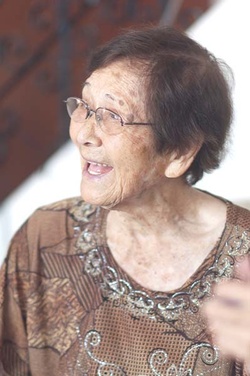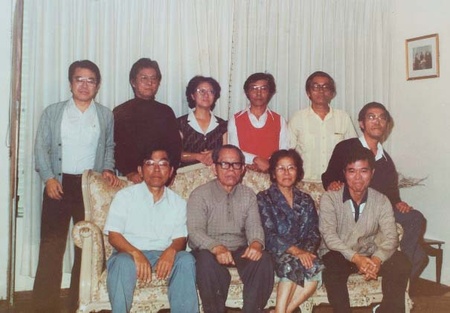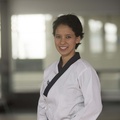Part 1 >>
Living naturally
Every Wednesday Tsuyo Toyama goes to the Jinnai Center where she spends the day with other obaachan. “I am very content,” she affirms. They sew and do calligraphy, among other activities, and she praises the volunteers (“They are very polite and take care of us very well”)
She laughs when she mentions that the conversations with her Jinnai friends always touch upon their aches and pains (“it hurts me here, it hurts me there). And when they ask her why she doesn’t use a cane, how she walks without hunching over, what she does to maintain herself so well, what is her secret, she answers matter-of-factly: “I eat and walk, when I am tired I sleep, when I am hungry I shout gohan!1” Her friends celebrate her wisdom with laughter.
Tsuyo likes to work in her garden, exercises every day for 15-30 minutes, and eats everything. Her children say that she is always thinking of others and trying to resolve their problems.
Tsuyo obaachan has an iron will. Not too long ago she fell in the street and broke a bone. She had to endure a long recovery process, but she put her all into getting better. When her daughter-in-law wanted to bring food to her in her room, she replied, “No, I’ll come down for it.” Today, she walks around just fine, strong and in good health.
She played the piano until she turned ninety-three years old; at ninety-eight she was still washing her clothes; at ninety-nine she traveled to Costa Rica to visit some family.
At times she would leave her home and take a taxi to visit one of her nephews. Until two years ago she was even walking to visit family.
Once a woman came up to her and asked: “Are you Japanese or Chinese?” She responded, “Japanese.” Animated by her answer, the woman told her that she was able to build her house thanks to the money that a relative sent her from Japan. The stranger expressed her appreciation to Tsuyo as a representative of Japan, the country who put a roof over her head.
Gratitude is a two-way street. Thanks to Peru, Tsuyo Toyama was able to build a home, start a family, and have a life. 100 years have passed like a dream.
NOTES:
1. Food, rice
* * *
The Toyama Family
- Zensei and Tsuyo Toyama had eight children: Hajime, Takeshi, Mitsuru, Yasuko, Tetsuo, Hide, Adolfo, and Juan. Hajime and Mitsuru died. Takeshi and Juan live in Japan, Hide in Brazil, and Yasuko, Tetsuo, and Adolfo in Peru.
- Tsuyo Toyama has twenty grandchildren, nineteen great-grandchildren (and one on the way), and a great-great grandchild.
- Her family lives in various countries: Peru, Japan, Brazil, Turkey, Costa Rica, Italy, and Australia.
- Zensei Toyama was decorated by the Japanese government in 1980.
“Life is a Dream”
The idea of creating the JPCC began to take shape in 1961. Its completion in 1967 signaled a new beginning for the Japanese community. It was very difficult to obtain the funds for its construction. My husband Zenzei came home every night very tired and he always looked sick. Finally, we were able to raise the money and we began the project. A few months later the good news arrived that the royal family would visit us. The construction process quickened from that momento on. The workers started very early each morning and ended very late each night. My husband brought the workers grilled chicken and coffee. After much effort and hard work, opening day arrived. It was a great relief for my husband, but it also brought him immense joy. When I think of those days my heart begins to beat rapidly and I begin to cry. Truth be told, life is a dream.
Excerpt of Tsuyo Toyama’s speech at her 100th birthday party.
* This article was published thanks to an agreement between the Japanese-Peruvian Association and the Discover Nikkei Project. It was appeared originally in the journal Kaikan, volume 54, February 2011, and adapted for Discover Nikkei.
© 2011 Asociación Peruano Japonesa © 2011 Fotos: Asociación Peruano Japonesa / Álvaro Uematsu / Archivo de la familia Toyama












